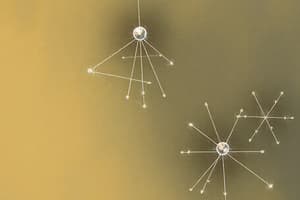Podcast
Questions and Answers
Which molecular geometry has an ideal bond angle of 180 degrees?
Which molecular geometry has an ideal bond angle of 180 degrees?
- Triangular pyramid
- Linear (correct)
- Bent
- Triangular planar
What is the molecular geometry of AX2E2 species?
What is the molecular geometry of AX2E2 species?
- Bent (correct)
- Tetrahedral
- Triangular planar
- Linear
Which of the following species would exhibit bond angles less than the ideal value due to the presence of lone pairs?
Which of the following species would exhibit bond angles less than the ideal value due to the presence of lone pairs?
- AX4
- AX3E (correct)
- AX2
- AX3
In terms of electron pair repulsion, which interaction is the strongest?
In terms of electron pair repulsion, which interaction is the strongest?
What is the ideal bond angle for tetrahedral geometry?
What is the ideal bond angle for tetrahedral geometry?
What is the electron pair geometry of a molecule with the formula AX3E2?
What is the electron pair geometry of a molecule with the formula AX3E2?
Which molecular geometry corresponds to the electron pair geometry of a triangular bipyramid when considering lone pairs?
Which molecular geometry corresponds to the electron pair geometry of a triangular bipyramid when considering lone pairs?
In the context of molecular geometry, which of the following statements is true for SF4?
In the context of molecular geometry, which of the following statements is true for SF4?
For a molecule classified as AX3E2, how many bonding pairs does the central atom have?
For a molecule classified as AX3E2, how many bonding pairs does the central atom have?
When considering lone pairs and their effect on molecular geometry, which option describes a fundamental difference from bonding pairs?
When considering lone pairs and their effect on molecular geometry, which option describes a fundamental difference from bonding pairs?
What type of orbital overlap characterizes a sigma bond?
What type of orbital overlap characterizes a sigma bond?
Which of the following best describes a pi bond?
Which of the following best describes a pi bond?
Which statement is true regarding covalent bonds?
Which statement is true regarding covalent bonds?
How do sigma and pi bonds differ in their formation?
How do sigma and pi bonds differ in their formation?
Which of the following statements is false about sigma and pi bonds?
Which of the following statements is false about sigma and pi bonds?
What is the location of the negative charge center in a water (H2O) molecule?
What is the location of the negative charge center in a water (H2O) molecule?
How is the charge distribution in a water molecule (H2O) characterized?
How is the charge distribution in a water molecule (H2O) characterized?
Where is the positive charge center located in a water molecule?
Where is the positive charge center located in a water molecule?
Which statement correctly describes water's (H2O) molecular polarity?
Which statement correctly describes water's (H2O) molecular polarity?
What type of molecule is water based on its charge distribution?
What type of molecule is water based on its charge distribution?
Flashcards
Lone pair repulsion
Lone pair repulsion
The repulsion between lone pairs of electrons is stronger than the repulsion between a lone pair and a bonding pair, which is stronger than the repulsion between two bonding pairs.
Electron pair geometry
Electron pair geometry
The arrangement of electron pairs around a central atom.
Molecular geometry
Molecular geometry
The actual shape of a molecule, taking into account the positions of both bonding and lone pairs.
Tetrahedral bond angles
Tetrahedral bond angles
Signup and view all the flashcards
Observed bond angles
Observed bond angles
Signup and view all the flashcards
See-saw molecular geometry
See-saw molecular geometry
Signup and view all the flashcards
See-saw molecular geometry
See-saw molecular geometry
Signup and view all the flashcards
Effect of lone pairs on molecular geometry
Effect of lone pairs on molecular geometry
Signup and view all the flashcards
Triangular bipyramid electron pair geometry
Triangular bipyramid electron pair geometry
Signup and view all the flashcards
Polar molecule
Polar molecule
Signup and view all the flashcards
Center of negative charge
Center of negative charge
Signup and view all the flashcards
Center of positive charge
Center of positive charge
Signup and view all the flashcards
Polarity
Polarity
Signup and view all the flashcards
Electronegativity
Electronegativity
Signup and view all the flashcards
Sigma Bond
Sigma Bond
Signup and view all the flashcards
Pi Bond
Pi Bond
Signup and view all the flashcards
Nonpolar Covalent Bond
Nonpolar Covalent Bond
Signup and view all the flashcards
Polar Covalent Bond
Polar Covalent Bond
Signup and view all the flashcards
Study Notes
General and Inorganic Chemistry PHCM101
- The lecture is titled Synthetic and Natural Organic Polymers
- The lecture is part of a series, numbered as lecture 12
- The lecturer's name is Dr. Nesrine El-Gohary
Competencies
- Define polymers and different types of polymerization reactions
- Differentiate between different stereoisomers
- Demonstrates understanding of different types of polymers (natural and synthetic)
- Differentiate between thermoplastic and thermoset polymers
Polymers
- A polymer is a large molecule (macromolecule) of high molecular weight made up of many repeating chemical units called monomers.
- Naturally occurring polymers include proteins, nucleic acids, cellulose, and rubber.
- Synthetic polymers include Dacron, Nylon, Teflon, and Kevlar.
Classification of Polymers
- Polymers are classified according to their synthesis method (addition or condensation), origin (natural or synthetic), and physical properties (thermoplastic or thermoset).
Revision on some basic organic Chemistry concepts
- Alkanes: Simplest organic molecules, consisting only of carbon and hydrogen atoms with only single bonds (sigma bonds).
- Alkanes List: Methane, Ethane, Propane, Butane, etc. A list by number of carbon atoms is given.
- Alkenes: Hydrocarbons containing at least one carbon-carbon double bond (molecule contains a pi bond).
- Alkynes: Hydrocarbons containing at least one carbon-carbon triple bond (molecule contains two pi bonds).
Free Radicals
- A molecule or atom having an unpaired valence electron is called a free radical.
- Free radicals are highly reactive.
- Free radicals are involved in addition polymerization.
- Free radicals attack weak bonds (pi bonds) in alkenes or alkynes.
Functional Groups
- Carboxylic group: A-C(=O)OH
- Amino group: -NH2
- Amide group: -C(=O)NH-
- Alcohol group: -OH
- Ester group: -C(=O)O-
Synthesis of Polymers
- Addition Polymerisation: Monomers add together to form the polymer without any loss of atoms. A carbon-carbon double or triple bond is needed in the monomer.
- Ethylene (ethylene monomer): Forms Poly(ethene) (polyethylene) with addition polymerization
Mechanism of addition polymerization
- Initiation: An initiator breaks a double bond.
- Propagation: Chain growth occurs.
- Termination: Chain growth stops.
Addition Polymerisation
- The polymer is the only product.
- Reaction proceeds by a free radical mechanism.
- Involves the opening out of a double/triple bond, where the free radical attacks the pi bond.
- Conditions are high pressure, temperature and an initiator (to provide the initial free radical).
- Peroxides are often used as initiator/catalyst(source of free radical).
- Conditions of the reaction can alter the properties of the polymer.
Homopolymer
- Polymers made up of only one type of monomer
Copolymer
- Polymers made up of two or more monomers
Poly(propene) and stereoisomerism
- Stereoisomers: Molecules with the same atoms, connected in the same sequence, but atoms are positioned differently in space.
- Isotactic: A very regular type of polymer chain; all methyl groups are on the same side.
- Syndiotactic: A slightly less regular but still very ordered polymer; methyl groups alternate sides of the chain.
- Atactic: A completely random allocation of methyl groups, weakest polymer, lowest melting point.
- Degree of randomness affects polymer strength and melting point.
- Catalysts can direct polymerization towards more ordered forms.
Synthesis of polymers (Condensation polymers)
- Involves two or more monomers with different functional groups.
- Elimination of water or another small molecule.
Polyesters
- Dacron is a polyester.
- A polymer of benzene-1,4-dicarboxylic acid and ethane-1,2-diol (ethylene glycol).
- Ester linkage is formed between monomers.
Polyamides
- These polymers involve the linkage of two monomers (amine and acid) through the amide linkage (as in nylon).
- Nylon 6,6 is a specific type of polyamide.
Kevlar polyamide
- Kevlar is a polyamide.
- Polymer of benzene-1,4-dicarboxylic acid and 1,4-diaminobenzene
Uses of Polyesters and Polyamides
- Main use is as fibers in clothing.
- Often blended with natural fibers (like cotton) to give desired properties.
Natural and Synthetic Polymers (Proteins)
- Condensation polymers, repeating units are amino acids
- All amino acids contain at least one carboxyl group and one amino group.
- Proteins are polyamides, specifically called polypeptides.
- Key role in biological processes (enzymes, hormones, supports, protection)
Natural and Synthetic Polymers (Nucleic acids)
- Condensation polymers, repeating units are nucleotides.
- Nucleic acids are polynucleotides.
- Contain information for building and functioning of an organism (DNA & RNA)
Natural and Synthetic Polymers (Cellulose)
- Condensation polymer, long chain of repeating glucose units.
- Cellulose is a polysaccharide.
- Major component of woody plants and cotton.
- Useful in textiles and paper production.
- Can be chemically modified (e.g., with nitric acid to make explosives).
Natural and Synthetic Polymers (Rubber)
- Addition polymer, repeating units are a monomer called isoprene.
- Natural rubber is obtained from latex of rubber trees.
- Latex is an aqueous suspension of rubber particles.
- Rubber is described to be:
- Tough
- Elastic
- Soft and sticky when hot.
- Vulcanization (linking chains with sulfur) improves properties.
Synthetic Polymers
- Polyethene, polypropylene, nylon, Dacron, Kevlar, and styrene-butadiene rubber.
Thermoplastic and Thermoset polymers
- Thermoplastic: Polymer that can be softened by heating and then molded into desired shapes.
- Thermoset: Polymer that cannot be softened by heating and so cannot be remolded.
Exercise (multiple choice questions)
References
- Raymond Chang, Chemistry, 11th Edition, McGraw-Hill Companies.
General and Inorganic Chemistry (PHCM101) Lecture 7 (Bonding; General Concepts II)
- Valance-Shell Electron Pair Repulsion Model (VSEPR): Explains molecular shapes by electron-pair repulsions.
- Predicting effect of unshared/multiple bonds on geometry
- Predicting the polarity of molecules
Recap: Drawing Lewis structures
- Steps for drawing Lewis structures
Molecular Geometry
- General shape of a molecule, three-dimensional arrangement of atoms
- Diatomic molecules (linear)
- Polyatomic molecules (bond angles)
- Effect of lone pairs
Molecular Geometry (multiple bonds)
- Multiple bonds occupy the same space region as single bonds
- Multiple bonds do not affect molecular geometry.
Molecular Geometry (effect of lone pairs)
- How lone pairs affect molecular geometry.
- Electron-pair geometry vs. molecular geometry
Valence Bond Theory
- Atomic orbitals combine to form molecular orbitals for bonding.
- Hybridization: Mixing of native atomic orbitals to create special orbitals for bonding (e.g., sp3, sp2, sp)
- How to determine hybridization from the number of effective electron pairs. (e.g lone pairs, single, double, triple bonds)
Additional Topics
- Various topics relating to covalent and sp, sp2 and sp3 Hybridization for different kinds of chemical species
- Types of Covalent bonds (sigma and pi)
Studying That Suits You
Use AI to generate personalized quizzes and flashcards to suit your learning preferences.




